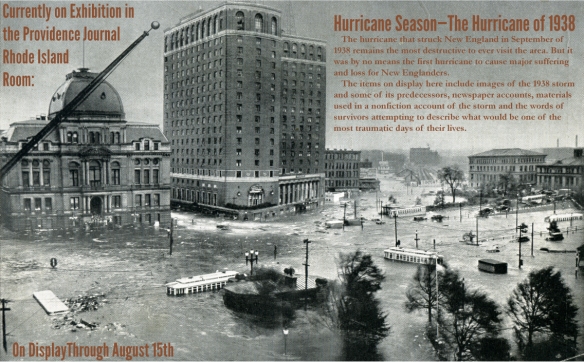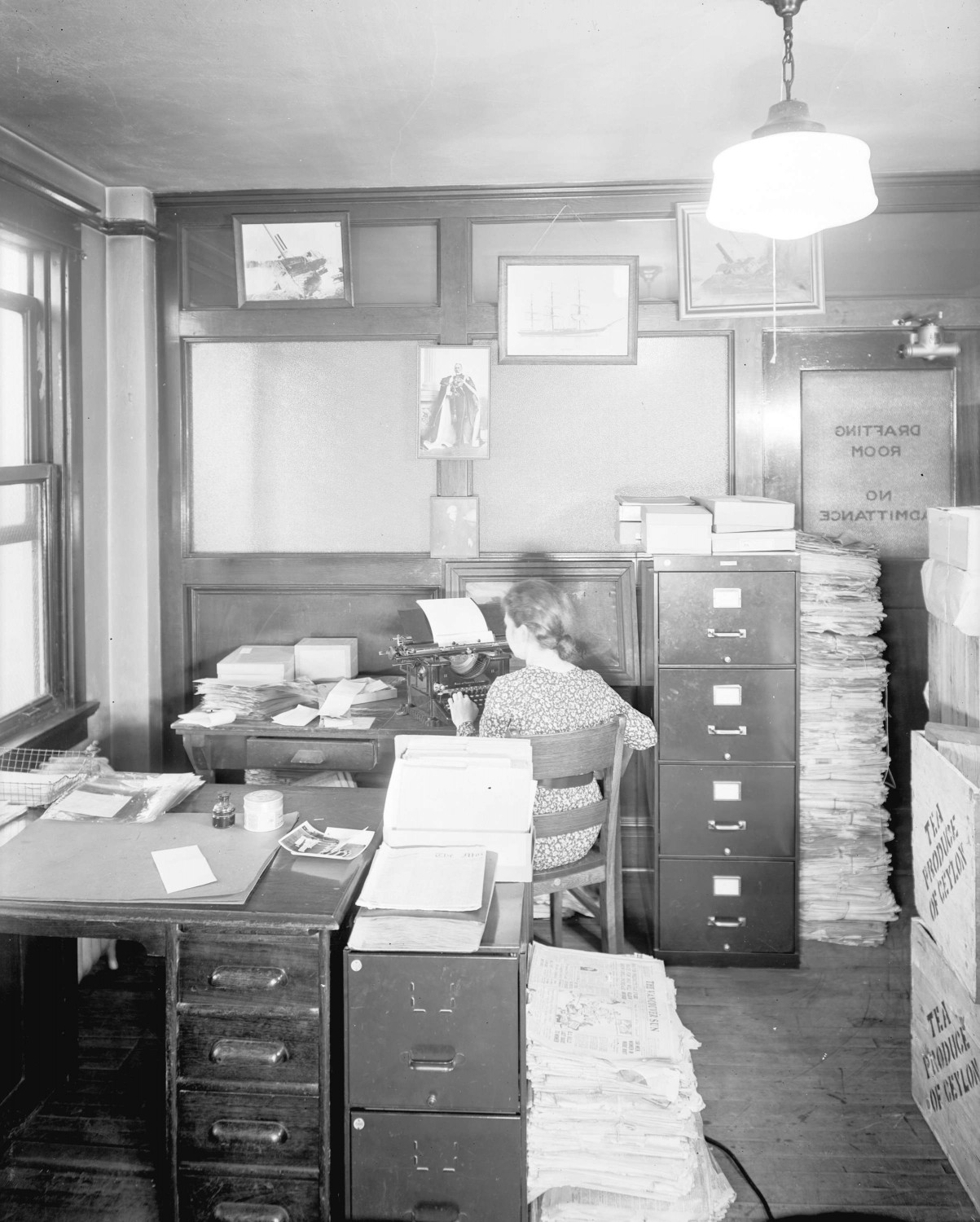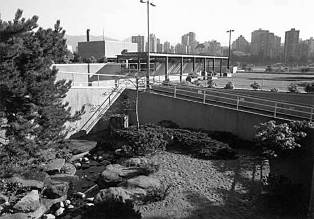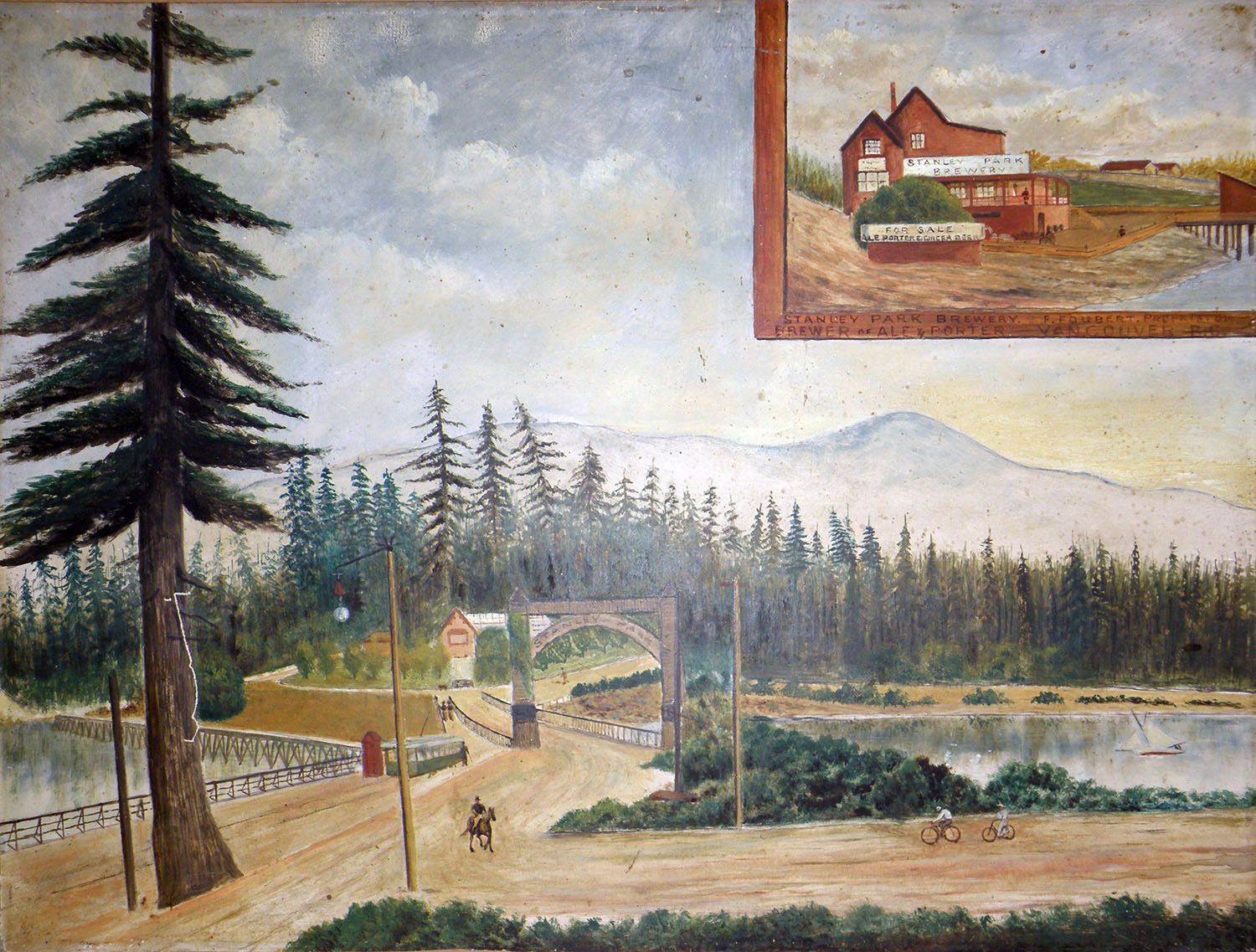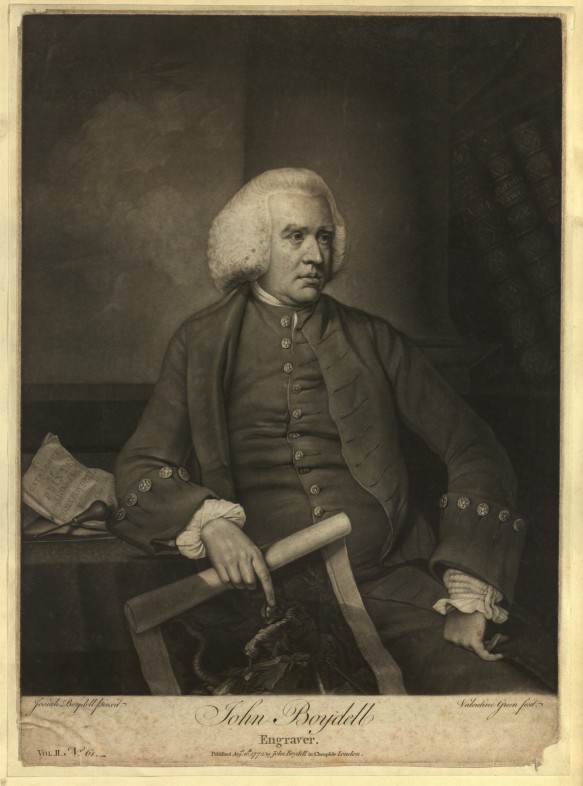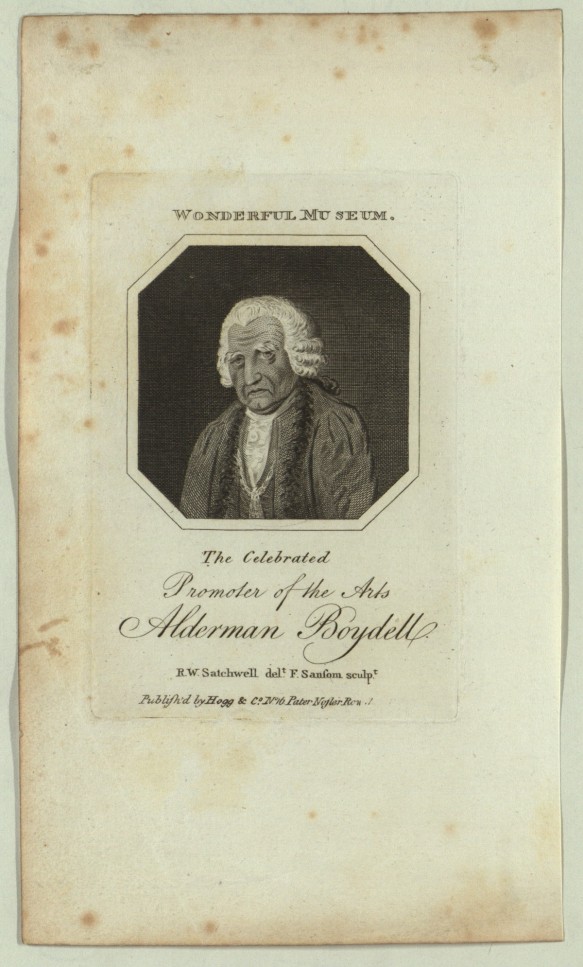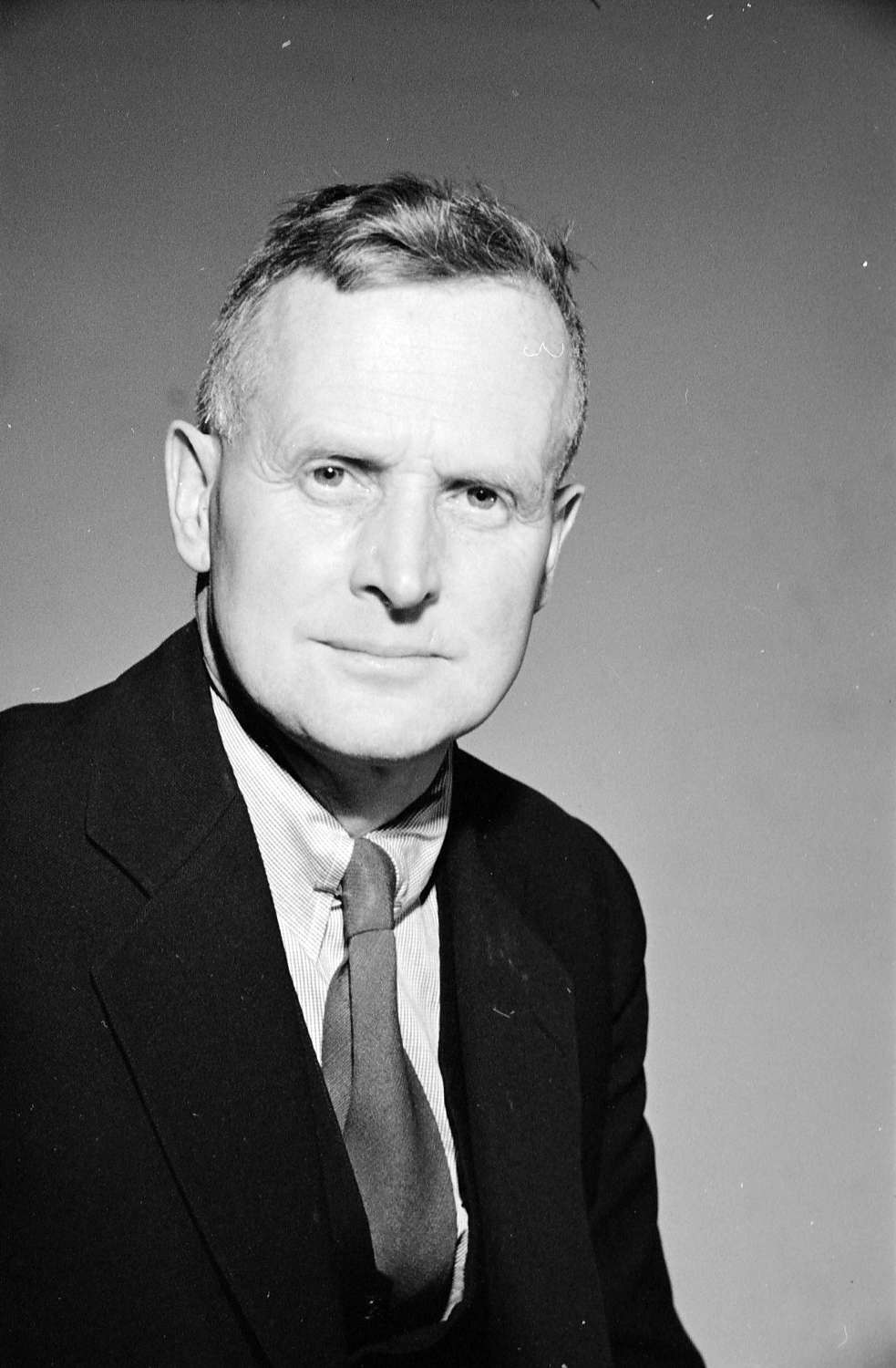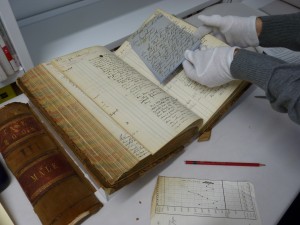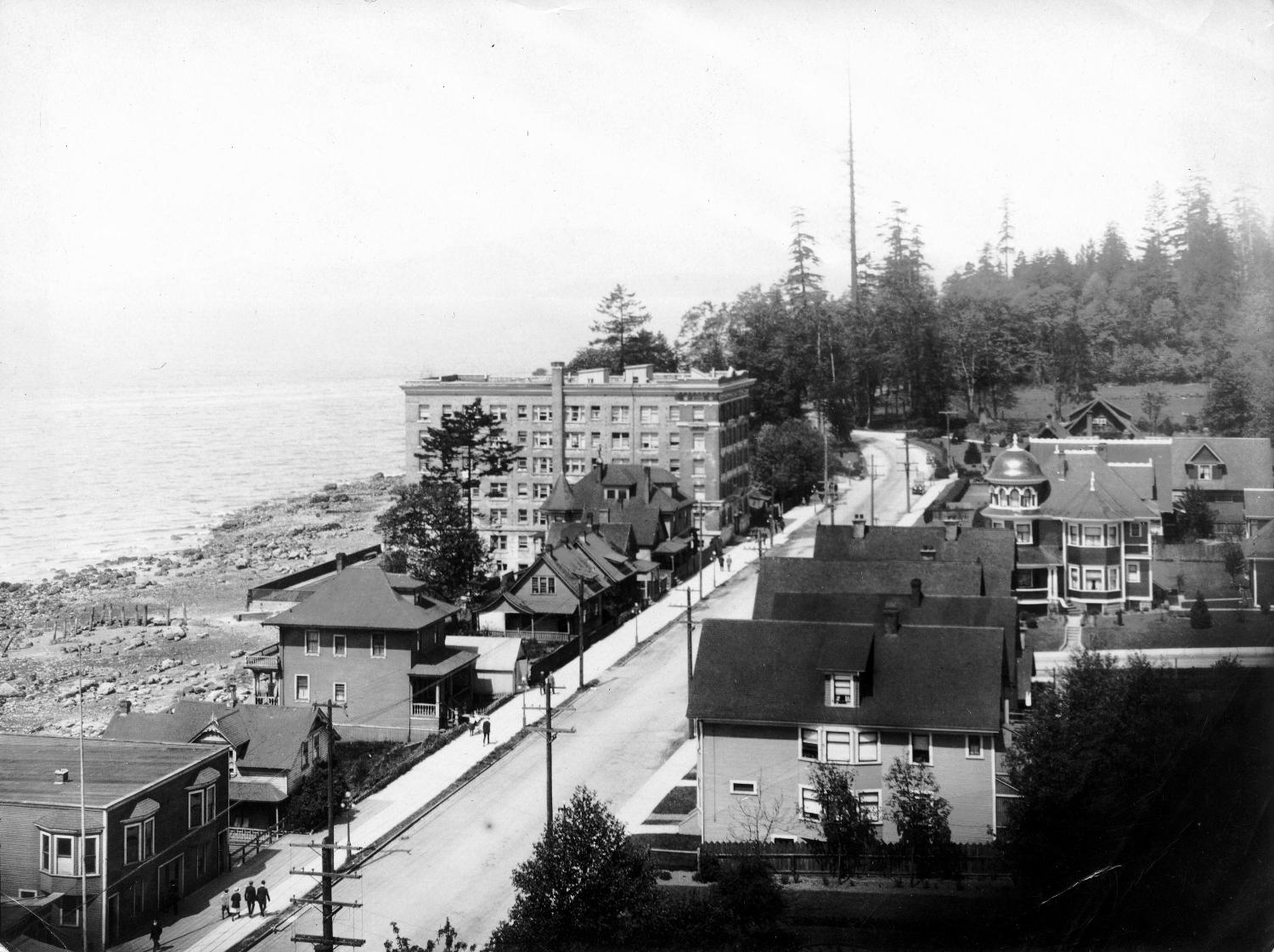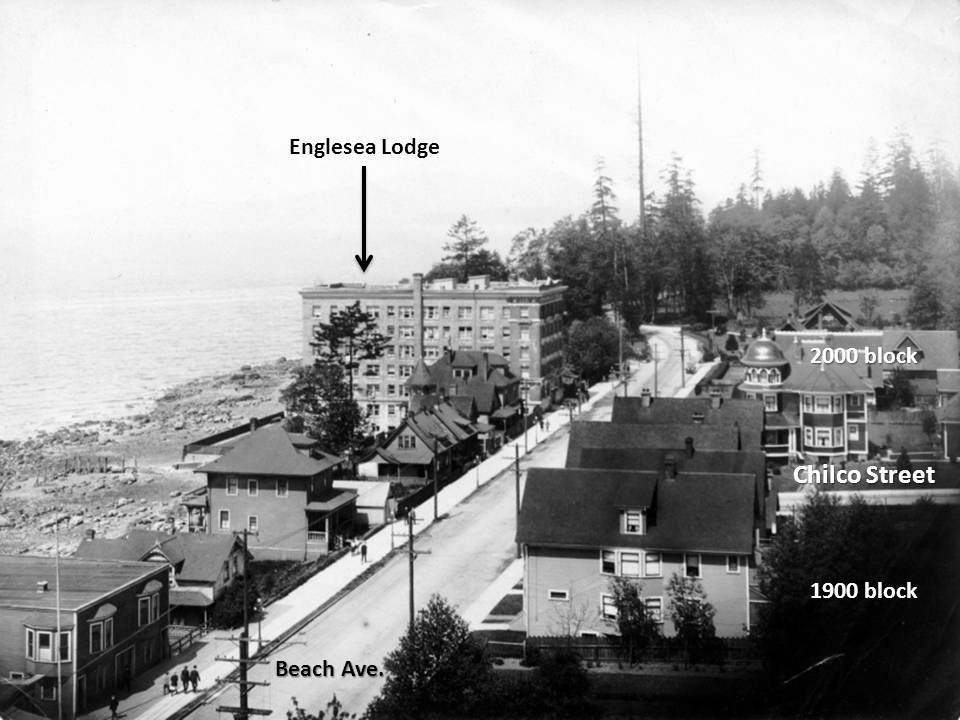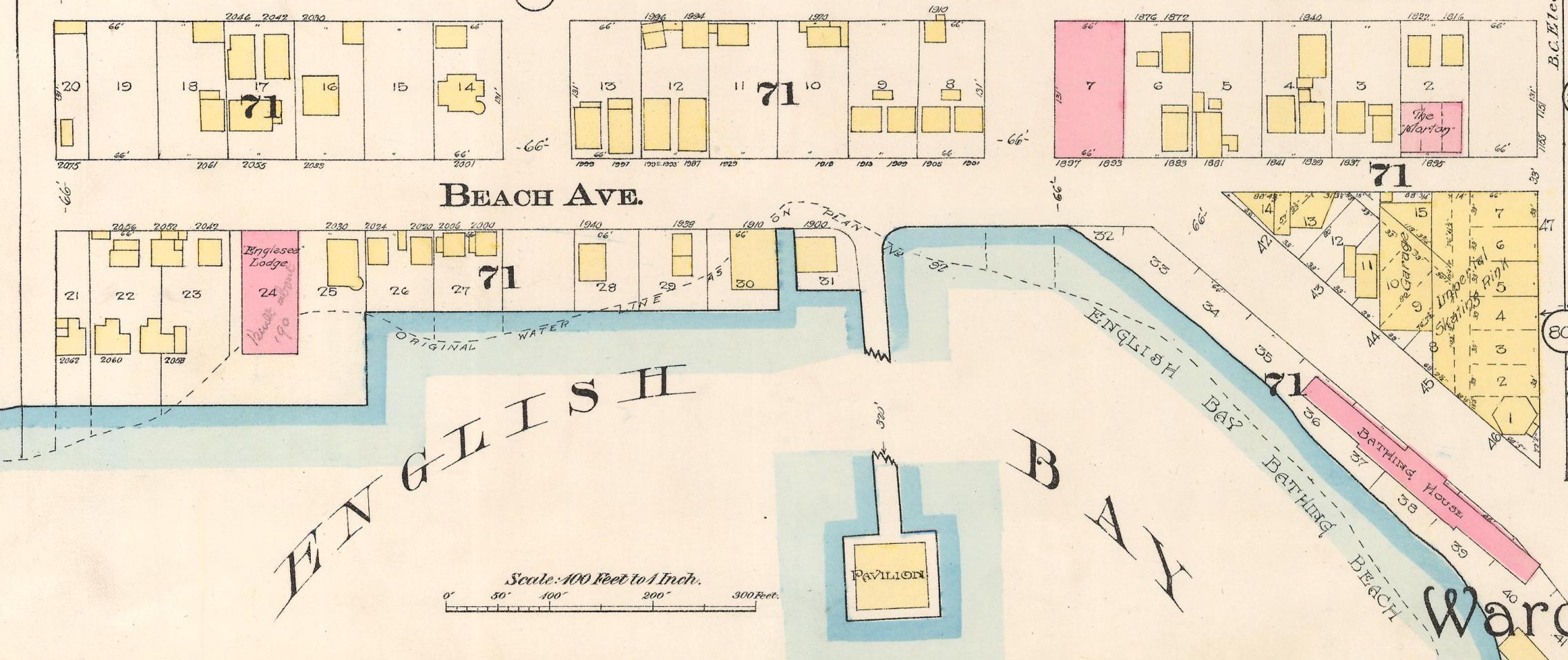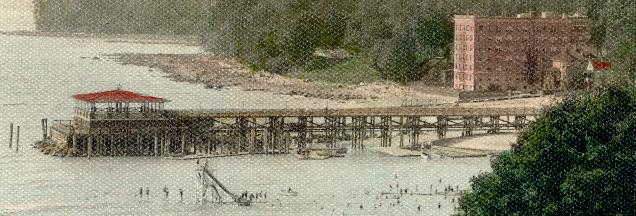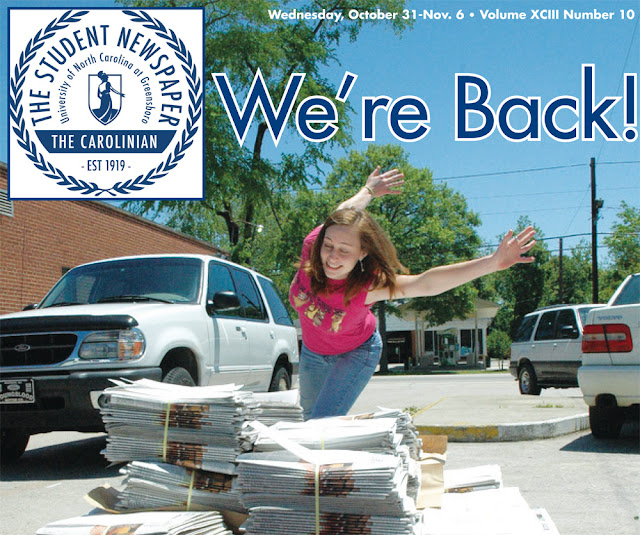Listen to a 23-year-old Sylvia Porter, the inventor of the personal finance column, on WQXR’s Author Meets Critics (1936).
Category Archives: English
The History of Pride in the Bloom Collection
In honor of LGBT Pride month, I want to call attention to the substantial runs of historic gay newspapers that are part of the Marshall Bloom Alternative Press Collection. These are just a few samples of the many publications in the Bloom Collection that document the struggle for gay rights throughout the 1970s and beyond. You can find many more examples in Bloom by searching the finding aid for publications with “gay” in the title, but there are less obvious titles as well (Mom…Guess What! for instance).
While Bloom is frequently used by students in the departments of Black Studies and Law, Jurisprudence, and Social Thought, the collection is a rich source for researching the history of the LGBT community during the last quarter of the twentieth century.
Flat Stanley’s Magical Visit to Washington
Just before Memorial Day, Eva Wall, a third grader at the Fiske School in Wellesley, Massachusetts wrote to tell me that her class was working on a Flat Stanley project. If you are not familiar with Jeff Brown’s 1964 children’s classic, illustrated by Tomi Ungerer, check it out. Eva sent me a hand colored flat Stanley and my assignment—write an illustrated short story about Stanley’s visit to Washington.
Stanley and I wandered up and down the Mall looking for photo ops. At the White House a friendly security guard reminded me that sticking things through the fence was not allowed—after Stanley had already posed on the other side!
He really wanted to climb the Washington Monument but the restoration work forced him to settle for a view from a nearby tree limb.
We stopped at the National Archives, of course, and dropped in on the Archivist of the United States.
But the real excitement came on Memorial Day when Stanley got to ride on a float in the parade down Constitution Avenue.
And who should he meet along the route? George Washington, himself!
And last week Eva got to share Stanley’s adventures with her classmates. I heard that Stanley’s picture with George Washington is hanging on the bulletin board! Thanks, Eva!… [ Read all ]
Founders Online
This afternoon, the National Archives launched Founders Online—a tool for seamless searching across the Papers of George Washington, Thomas Jefferson, James Madison, Benjamin Franklin, John Adams, and Alexander Hamilton. Our National Historical Publications and Records Commission (NHPRC) has been funding these projects in paper for some time. Working with Rotunda at the University of Virginia Press and the editors of the six papers project, Founders Online was created with NHPRC funding to provide simultaneous searching across all six collections at once.
Through Founders Online you can now trace the shaping of the nation, the extraordinary clash of ideas, the debates and discussions carried out through drafts and final versions of public documents as well as the evolving thoughts and principles shared in personal correspondence, diaries, and journals. This beta version of Founders Online contains over 119,000 documents, and new documents will be added to the site on a continual basis.
You can see first-hand the close working partnership between George Washington and Alexander Hamilton from their time in the Revolutionary War to Hamilton’s draft of Washington’s Farewell Address. Or read John Adams’ description of Congress as a place where “There is so much Wit, Sense, Learning, Acuteness, Subtilty, Eloquence, etc. among fifty Gentlemen, each of whom has been habituated to lead and guide in his own Province, that an immensity of Time, is … [ Read all ]
PMM at 50
Fifty years ago in London the International Printing Machinery and Allied Trades Exhibition included an ambitious exhibition on the influence that the invention of the printing press had on the 500 years of human history that followed. The exhibition was called “Printing and the Mind of Man,” and it was followed by a 1967 catalog that listed hundreds of books (and some ephemera) crucial to the history of the western world.
In celebration of the golden anniversary of Printing and the Mind of Man, over the course of the next few months we’ll be putting on display a rotating selection of items from our collection that appear in the catalog. So you can stop by, take a look at the description of why (to take our first example) The Federalist was important, and then look at a copy of The Federalist sitting nearby.
The PMM selections will be in the third-floor case near Special Collections. And while you’re at the Library you can also check out our exhibition on the hurricane of 1938 in the main gallery downstairs:
The Evil in Eavesdropping
Long before FISA and PRISM, New York State politicians struggled with maintaining the delicate balance between personal privacy and public safety.
Police-state menace or weapon to protect our liberties?*
Illegal wiretapping became a hot issue in the 1950s, particularly after Teamster President-elect Jimmy Hoffa was brought to trial for the crime in 1957. Hoffa had been accused of tapping the telephones of subordinates in the union’s Detroit headquarters. The trial gained wide national attention when Hoffa’s own conversations were were made public – the result of government wiretaps between Hoffa and reputed organized crime figure Johnny Dio.
Several scandals made the practice especially controversial in New York state —most notably, the wiretapping of Charles McGuinness, the Greenwich Village lawyer who had challenged Tammany Hall boss Carmine DeSapio for district leader. In this November 8, 1959 episode of WNYC’s Campus Press Conference (1951-1962), Host Jay Nelson Tuck and a few earnest university newspaper editors question the Chairman of New York’s Joint Legislative Committee to Study Illegal Interception of Communications, Anthology P. Savarese Jr.
Savarese’s comments on the program are measured and diplomatic. While his committee had created measures to prevent the use of illegal wiretaps in civil cases, he was unable to convince Albany to make them inadmissible in criminal cases. Ultimately, Savarese seems confident that government agencies will go through the proper channels in order to obtain court orders for wiretapping —although he admits that in a pinch (the hot pursuit doctrine), police could still wiretap before asking for a court order. “They wouldn’t do it unless they had really good basis for doing it. If they did it too often…the court would get annoyed,” Savarese says.
The panel of college cub reporters raises a number of issues with Savarese, including what kind of oversight the FCC has at the federal level when it comes to state’s wiretapping laws. “If the states are charged with the right or with the responsibility of maintaining law and order,” Savarese replies, “then they must be permitted to determine how they will investigate crime and how they will prosecute it. And the federal government shouldn’t prevent legitimate law enforcement techniques to be dictated by the states.”
The controversy would not abate until the passage in 1968 of the Omnibus Crime Control and Safe Streets Act, which included the first federal regulation of wiretapping in its Title III. The continuing growth of electronic communications ensure that similar issues will be in the news for the foreseeable future.
*question posed by Don Whitehead in the Feb 7, 1954 The Milwaukee Sentinel article, “Legalized Wiretapping: Danger to Freedom or Aid to Nation’s Security?”
“Terras Irradient: Shining a Light on the Past”
Visitors to the Frost Library in the spring of 2013 were met in the lobby with an exhibition put together by students from Wendy Ewald’s class Collaborative Art: The Practice and Theory of Working with Communities. Items in the exhibition were selections from archival collections the students had used in classroom meetings during the 2012 fall semester. The resultant class projects used the Amherst College missionary collections for the historical part of their work and interviewed local people for the contemporary part. The class then produced an exhibition and a book that connected the two projects. Enlarged pages from the book were also on display in the mezzanine gallery above the lobby exhibition.
Exhibition viewers might have wondered how Amherst College came to possess so much material about Christian missionaries. As many people will know, Amherst College was founded with the object of “educating for the gospel ministry young men in indigent circumstances, but of hopeful piety and promising talents.” When Noah Webster described this mission at the laying of the cornerstone of South College in August of 1820, he could not have imagined exactly how and to what extent it would play out. However, in the decades that followed his assertion, Amherst turned out approximately 140 missionaries for 20 countries. Many of those missionaries founded something resembling dynasties, in which succeeding generations followed their parents and grandparents into missionary service. Because of the strong connection between the College and its alumni, many of the missionary families eventually deposited their papers here, over time forming an impressive group of missionary collections.
One need not be religious, or interested in the study of religion or the missionary movement, to find these collections fascinating and extraordinarily important. In general, the collections provide a rich context for study of our history in the Middle East and India in particular, with a few collections covering other countries. However, the collections may also be approached from many other angles, including international history, American history, history of religion, politics, women’s studies, as well as a basic biographical approach to any one of the individuals represented in the collections.
Consider, as an example of the latter approach, the four wives of missionary William Frederic Williams (1818-1871), Sarah, Hattie, Carrie, and Kate. Taken together, their lives span nearly a century, with much of that time spent living in the Middle East. What would the archival records – diaries, letters, photographs, documents – tell us about their personal lives, or about the role of women in missionary families in the 19th century? How did they view themselves, their lives, their work? These women had careers at a time when most American women didn’t. Did they recognize this fact in the manner that we do, and did they acknowledge it in some fashion, or was it unquestioned? To what extent did women deliberately seek out this work as one of the few socially acceptable ways in which to carve out a career, or to put it differently, what kind of woman decided to leave her home in America for a distant, unknown land in order to do missionary work? What was the stronger impulse, religion or adventure? Certainly some women came to the work because they married men who were already or about to be missionaries, but others went out to work as missionaries on their own and married missionary men they met abroad.

The four wives of William Frederic Williams: top row, left to right, Sarah Pond and Harriet Harding; bottom row Carrie Barbour and Kate Pond. First wife Sarah Pond Williams was the mother of journalist and educator Talcott Williams (AC 1873).
For that matter, one could flip the standard route and look at the life of Laura Bliss, daughter of Edwin E. Bliss, Class of 1837, and his wife Isabella, missionaries in Turkey from 1844-1896. Laura was born in Turkey in 1846 and referred to Turkey as “home” for most of her life. She did missionary work there (with mixed success) as a young girl, but then married a missionary posted in America (Langdon Ward) and thus gave up her work in Turkey in order to raise a large family in Massachusetts. Laura Ward experienced an early career as a single female missionary and then a later one as wife and mother in America. All her children grew up to be missionaries, as did some of their children. I could go on (just ask my colleagues) – the possibilities for research topics from our missionary collections seem infinite to me, and getting to know the people in the collections is the next best thing to time travel.
Another well-documented, very obvious topic in several of our collections is the conflict between the Turks and the Armenians. As Christian missionaries posted to the Ottoman Empire, the families represented in the papers would have identified with and focused their labors on the Armenians, who had a history of Christianity. Many collections illuminate this topic, including, for example, the letters of Isabella Bliss to her children in the twenty years between 1876 to 1896, most of them written from her home in Scutari (now Üsküdar),Turkey. These letters, in Isabella’s very legible handwriting, provide numerous details about events in Turkey, revealing both what Isabella understood to be the situation as well as how the conflict affected her own situation in Scutari. Later generations of Blisses and Wards (Isabella’s grandchildren and great-grandchildren) experienced events that grew out of what Isabella had witnessed, giving the family a perspective on the history of the region that spanned four generations.
Another example of a resource about the conflict in Turkey may be found in the photograph albums in Charles Weeden’s papers. The Weeden papers document a later period, the 1920s.
All of the collections are readily available to researchers. We would welcome students who might be interested to visit the Archives and speak with one of the staff members about paper or project topics. We will continue to improve and add to the collections and their documentation over time, and we also have a long-term goal of describing the links among the collections, thereby providing a sense of the community of missionaries with connections to Amherst College.
In case you didn’t get to see the exhibition in Frost, here are a few items from several of the collections.

William Earl Dodge Ward (seated on right), son and grandson of missionaries, and married to Dora Judd Mattoon Ward, herself a missionary. With his staff in Bombay, c. 1930. From the William Earl Dodge Ward (AC 1906) Papers. Dora Ward’s papers are also in the archives.

Luminaries in the missionary field: J. W. Parsons; Isaac Grout Bliss (AC 1844); D. Ladd; Edwin Elisha Blss (AC 1837); Aug. Walker; Cyrus Hamlin; Elias Riggs (AC 1829); William G. Schauffler; H.G. O. Dwight; William Goodell; and Henry Van Lennep (AC 1837). Constantinople, 1859. Whether one agrees with their goals or not, these missionaries wrote lively, thought-provoking letters and journals that provide a lot of history for the times and places in which they lived.

All in the Family: Photo album from Paul Langdon Ward (AC 1933). Ward was the son of missionaries Edwin St. John (AC 1900) and Charlotte A. Ward (MHC 1903) and the grandson of missionaries Edwin E. (AC 1837) and Isabella Bliss. He was born in Diarbekr, Turkey, and was schooled in Beirut and at Deerfield Academy before attending Amherst. Paul became what might be called a “scholar-diplomat” and spent some of his long, distinguished career in China. He was also the president of Sarah Lawrence College from 1960-65.

Charlotte Allen Ward (MHC 1903) and her children. Passport photo (1916) in Paul Langdon Ward (AC 1933) Papers.

Charlotte Allen Ward with two of her children (Esther and Paul), Beirut, 1913. From the Paul Langdon Ward (AC 1933) Papers.

“Beirut Harbor”: Page from Esther G. Ward Easton’s photograph album. Esther was a daughter of Edwin St. John Ward (AC 1900), a doctor and missionary with long service in the Middle East. Album is in the Paul Langdon Ward (AC 1933) Papers.

Near Orfu. From an album in the Charlotte Allen Ward Papers at Mt. Holyoke College.
![Howard Bliss (AC 1882), son of Daniel Bliss (AC1852) and his wife Abby Maria Wood, standing in center of back row, with faculty from the Syrian Protestant College (now the American University of Beirut). His father, Daniel Bliss, was a founder of the college, and Howard followed in his footsteps, serving as president from 1902-20. This line of Bliss missionaries are cousins to Edwin Elisha Bliss and his line. Photograph from the [Daniel] Bliss Family Papers.](http://consecratedeminence.files.wordpress.com/2013/06/howard-bliss-with-spc-faculty-c1876-b3f5.jpg?w=500&h=578)
Howard Bliss (AC 1882), son of Daniel Bliss (AC 1852) and his wife Abby Maria Wood, standing in center of back row, with faculty from the Syrian Protestant College (now the American University of Beirut). His father, Daniel Bliss, was a founder of the college, and Howard followed in his footsteps, serving as president from 1902-20. This line of Bliss missionaries are cousins to Edwin Elisha Bliss and his line. Photograph from the [Daniel] Bliss Family Papers.
History Of The Archives
This post was written by Marek Bula.
The Archives has a long history. Here’s a look at how we grew.

J.S. Matthews’ home, where the archives were kept before being moved to the Holden Building in 1931. Reference code AM54-S4-: Str P90.01
In 1931, Major J.S. Matthews’ extensive personal collection of photos and documents relating to Vancouver was moved to the Holden Building, Vancouver’s temporary City Hall at 16 East Hastings. This included thousands of documents and photographs—such as interviews with early pioneers and aboriginal people—relating to the history and development of the City of Vancouver.
Matthews’ collection would become the basis for the City of Vancouver Archives. However, it wasn’t until June 8, 1933, that Matthews was appointed as Vancouver’s first City Archivist by Vancouver City Council for a rate of pay of just $25 a month, the equivalent of $400 dollars a month today, a salary that remained unchanged until his death on October 1, 1970. During his tenure as City Archivist, J.S. Matthews fought constantly with City Hall to improve the state of the Archives, his main grievances being the issues of funding and storage. He often used his own finances to pay for acquisitions. For example, after City Council declined to pay the $5,000 needed to acquire the St. Roch, he offered to pay half the cost. As a result, it now resides at the Vancouver Maritime Museum. One of his major complaints was the lack of storage space for the growing collection of archives. However, a building dedicated solely to the City Archives did not come to be until shortly after his death.
In 1936, the archives were moved from the Holden Building to Vancouver’s newly constructed City Hall at 12th and Cambie.
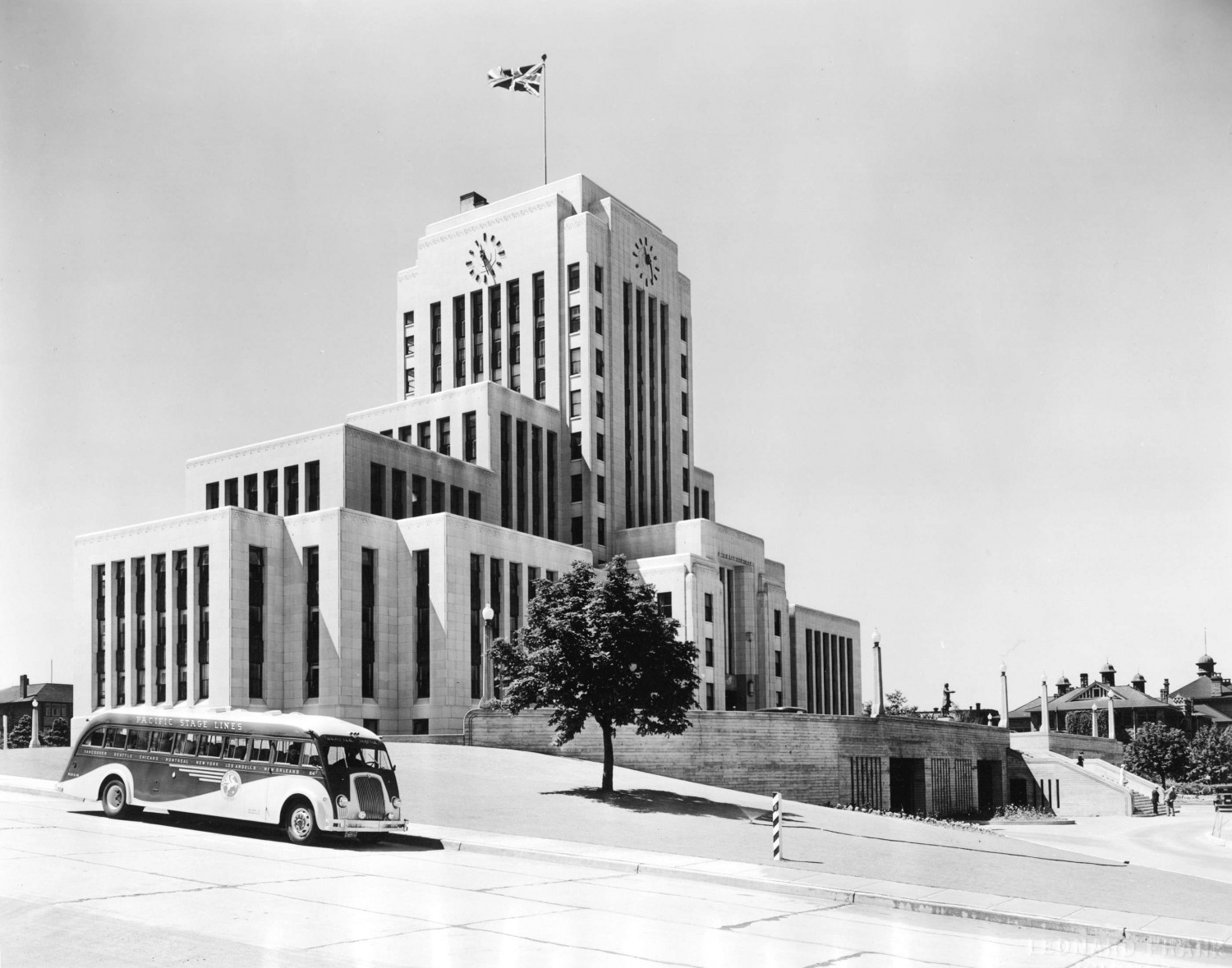
The archives were moved from the Holden Building to the new City Hall in 1936. Reference code AM54-S4-: City P21
A dispute with Mayor Gerry McGeer over ownership of the archives caused Matthews to move them back into his home temporarily. However, on December 20, 1938, Matthews reluctantly agreed to transfer ownership of the archives to a board of trustees appointed by City Council. On September 17, 1957, Mr. Justice Whitaker of the B.C. Supreme Court ordered that the City of Vancouver itself be the sole trustee of the archives. Three months later, the Archives was officially designated as a City department.
In 1959, the Vancouver Archives was relocated yet again, this time to Room 301 of the newly constructed Vancouver Public Library at 750 Burrard Street.

From 1959 to 1972, The Vancouver Archives was housed in Room 301 of the old Vancouver Public Library at 750 Burrard Street. Reference code
COV-S509-: CVA 778-18
It wasn’t until December 29, 1972, shortly after Matthews’ death, that the Archives found its permanent home at the James Skitt Matthews building, the first building in Canada to be built specifically for a municipal archives. The J.S. Matthews Building included a conservation lab and a full-time conservator on staff, which was almost unheard of for a municipal archives department.
Following Matthews’ death, Susan M. Baptie became the next long-term City Archivist.
In September, 1978, City Council passed the Records Retention and Destruction By-Law, which stated that City records could not be destroyed until the related “records retention and destruction schedule” was approved by the Department Head, the Director of Finance, the Director of Legal Services, the City Archivist and the City Clerk.
In 1992, the beginnings of an automation and database program for cataloguing and managing archives was introduced in an effort to facilitate archives management and to make public documents more accessible. The “automated records management system” was born. Public documents were made searchable through the database. The database grew every year, as archivists worked to a goal of encompassing the whole of the public archives. By 1997, the number of database entries had ballooned from 1,248 to 70,000 entries of descriptions of holdings.
In 1995, the City of Vancouver Archives website was created.
Shortly thereafter, a project was initiated to scan historic photographs and to make the existing database accessible via the website. By 2003, the database entries had grown to 147,568 entries, and 3.7 per cent of the one-million-plus photographs in the archives had been scanned.
In 1999, the Archives’ records management personnel were reassigned to the City Clerk’s Office and moved to the third floor of City Hall.
In 2001, a new 1,600-cubic-foot walk-in freezer for photographic negative preservation was researched, developed and installed. The freezer ensures that the collection of over one million photographic images are safeguarded and protected. The Friends of the Archives Photographic Cold Storage Facility was officially opened February 20, 2002 by Mayor Philip Owen.
In December 2003, the Archives was reintegrated with the City’s Records and Information Management program, and the City’s microfilm lab was added, to form the Records and Archives Division. 2003 also marked Sue Baptie’s retirement after 28 years of service as City Archivist.
In response to the growing use of digital records at City Hall, preparations were made at the Archives to deal with this. In 2005, a new position of Digital Archivist was created to handle the growing number of digital records, such as e-mail, word processing documents, digital photos and video. One of the first digital records acquired was a set of digital tapes of the Electoral Reform Commission’s public hearings. The hearings were broadcast on the internet, but they were never transcribed.
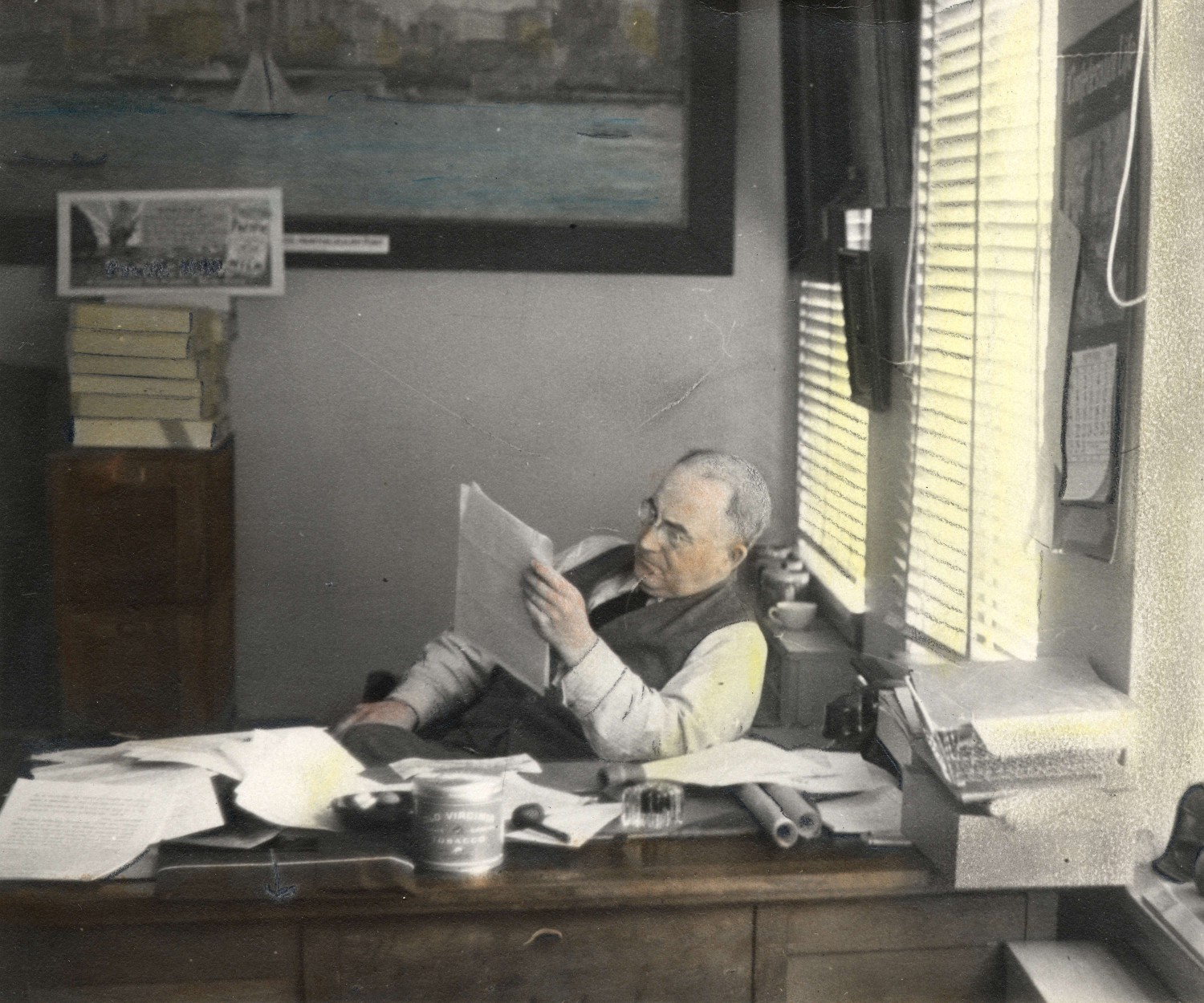
The Archivist at Work. This shows Major Matthews at his desk, and is attributed to B.W. Leeson. Reference code AM54-S4-: Port P567
As we look back on the history of the Archives, we are reminded of Major J.S Matthews’ determination to preserve the city’s records. Today we have maintained this value and more, as our mandate is to acquire, preserve, and make available these records, as well as private records of significant value to the documentary heritage of Vancouver.
Aiding in the Search for The White Bird
When Charles Lindbergh landed at LeBourget Field outside of Paris on the 21st of May 1927, among his first words- “Is there any news of Nungesser and Coli?” On the 8th of May, French aviators Charles Nungesser and Francois Coli took off from LeBourget in their plane, The White Bird, in an attempt to be first to fly nonstop from Paris to New York. French researcher, Bernard Decre, using the records of the National Archives, aims to tell the story of what happened to The White Bird.
Researcher Bernard Decre and National Archives staff member Mark Mollan at the French Embassy next to an exact model of the plane flown by the French aviators. Photo taken by Trevor Plante.
In May of 1919, French Hotelier Raymond Orteig offered a $25,000 Orteig Prize to the first aviator to fly across the Atlantic non-stop between New York and Paris- in either direction. Many aviators made unsuccessful attempts to capture the prize, but it was Charles Lindbergh flying The Spirit of St. Louis who won.
The French Government maintains that The White Bird went down in the English Channel and Mr. Decre has been working with Mark Mollan, our expert on U.S. Navy and U.S. Coast Guard records to prove that it made it across the Atlantic. Between May and August of 1927, using the logbooks of … [ Read all ]
SRO joins the memory of the world
Marnie Richardson
Tuesday, June 4, 2013 – 16:04
In 2000, Australia was the first country to establish a Memory of the World program with UNESCO with the vision that the world’s documentary heritage belongs to everyone. The program has since grown to include more than 60 countries and an extraordinary variety of documents illustrating the story of humankind which will remain preserved, protected and permanently accessible to all.

In May, State Archivist Cathrin Cassarchis was presented with a certificate acknowledging the inscription of the Convict Records of Western Australia 1838-1910 by the Australian Memory of the World Committee, together with those of New South Wales, Queensland and Tasmania. These records detail the forced emigration to Western Australia of over 9,000 convicts and now sit alongside other treasures such as the original scores of Beethoven, the Magna Carta and the Diary of Anne Frank.
There are a considerable number of records relating to the convict system held by the State Records Office including transportation lists, correspondence, medical journals and staff records. The State Records Office also holds a number of tickets of leave for those convicts lucky enough to be freed to seek employment.
You will find a listing of the relevant records in our convict records collection webpage or by searching for the archives through our online catalogue
All of WA’s Convict Records have been microfilmed and can be accessed by visiting the State Records Office of WA on weekdays between 9.30 – 4.30pm.
Describing Archives: A Content Standard, Second Edition (DACS) is Released
Describing Archives: A Content Standard, Second Edition (DACS) has been published. DACS facilitates consistent, appropriate, and self-explanatory description of archival materials and creators of archival materials. This new edition reflects the growing convergence among archival, museum, and library standards; aligns DACS with the descriptive standards developed and supported by the International Council on Archives; and provides guidance on the creation of archival authority records.
It can be viewed online at: http://files.archivists.org/pubs/DACS2E-2013.pdf
NIST Cloud Computing 6 Security Reference Architecture
NIST Releases Cloud Computing “Security Reference Architecture” (SP 500-299) for Public Comment.
You can view it here:
http://collaborate.nist.gov/twiki-cloud-computing/pub/CloudComputing/CloudSecurity/NIST_Security_Reference_Architecture_2013.05.15_v1.0.pdf
Sabrina

There’s been a lot of discussion recently about changing up the mascot. While there have been many suggestions for a new mascot, Sabrina has been put forth a number of times. As a campus presence since 1857, in the form of statue, humor magazine, a capella group, team nickname and legend, Sabrina makes a certain kind of sense as a mascot; in some ways she’s been serving as one for quite some time. However, I’d like to strongly suggest that, on a campus that has been working hard on sexual respect, perhaps a statue of a naked young woman with a 150+ year history of “abduction” and gender inflected manhandling would be a poor choice.
The statue of Sabrina (a mythical water nymph who had been human until her father’s spurned wife had her drowned in the river Severn) was donated to Amherst College in 1857 by Joel Hayden, State Lieutenant Governor (who bought it from a garden statuary catalog, which is why there are so many other Sabrinas floating around out there). It was on display in the college flower garden (near the Octagon and North College, roughly where Henry Ward Beecher is now) until 1884, when the administration, sick of the pranks that the students were playing with the statue, had it removed. The story goes that the college janitor was asked to break the statue up, but couldn’t bring himself to do it and instead hid it in his barn, where it was discovered four years later by students and became the subject a long period of inter-class rivalry.
The heart of the Sabrina tradition during its heyday (1880s-1930s), was the theft of the statue back and forth between odd and even classes and the presentation of the statue at the class banquet of whomever had possession of it. The banquets were a prime opportunity for the other classes to attempt to steal Sabrina back, and so they were generally shrouded in secrecy and intrigue and frequently were violently interrupted. During the actual banquet, toasts were made, pictures were taken and the tradition was for all the students to kiss the statue.

From reverse of photo: “Sabrina in John Henry’s barn night before football game, 1909” “This is the girl everyone wanted to kiss. Isn’t she pretty? I did not get a kiss this time as I was busy but I did not care much. She must have had enough to last her a year, and she did not say a word to any of them but let them do as they pleased.”

Max Shoop (AC 1910) and fellow students drove Sabrina across the field during the 1909 May 26th Amherst-Williams baseball game and got away safe due to their forethought in disabling all the vehicles present and locking the gates across the road.
The ante was eventually upped, with public showing of the statue at campus events, starting in 1909 and arguably peaking with a showing in 1919 in which there was a car chase, gun fire and a car accident that left a number of students injured.
 Interest and activity tapered off in the 1920s and finally, in 1934, the statue was given by the students to the college. It was refurbished and placed back on its base in the Hitchcock memorabilia room in Morgan Hall (the precursor of Archives and Special Collections). There were a number of theft attempts in the following decades (including one decapitation, quickly mended with some welding), but none successful until members of the Class of 1951 used an acetylene torch and the back stairway to make off with it the day before their graduation.
Interest and activity tapered off in the 1920s and finally, in 1934, the statue was given by the students to the college. It was refurbished and placed back on its base in the Hitchcock memorabilia room in Morgan Hall (the precursor of Archives and Special Collections). There were a number of theft attempts in the following decades (including one decapitation, quickly mended with some welding), but none successful until members of the Class of 1951 used an acetylene torch and the back stairway to make off with it the day before their graduation.
 They buried it in a barn for safekeeping and retrieved it the following year for a flyover appearance at a baseball game, with Sabrina hanging out the door of the small plane.
They buried it in a barn for safekeeping and retrieved it the following year for a flyover appearance at a baseball game, with Sabrina hanging out the door of the small plane.
In the end the class of 1951 gave Sabrina back to the college as well. It was displayed in Converse briefly in 1977 and promptly stolen (and just as promptly retrieved by campus police) and again, successfully, in 1984 until it was once again returned in 1994 (with two helicopter flights over sports games in between). The college has trotted the statue out for reunion with regularity during its periods of custodianship.
Since May 2008, Sabrina has once again been in the hands of the students. This time, you can catch up with her on facebook, where, refreshingly, she has a voice and the old, icky sexual objectification seems to be fully dispensed with. Nonetheless, I’d still say that the long, complicated history of Amherst students and Sabrina doesn’t lend itself to a cartoonish foam reincarnation.
Having given the Sabrina mascot idea a thorough airing, I’d like to humbly suggest an alternative: the Lady Amherst Pheasant – perhaps the perfect thing for a school whose main rival sports a cow mascot… and a fine reminder not to take ourselves too seriously.
If you find the history of Sabrina intriguing, you can find a whole lot more of it on our flickr site and in the archival Sabrina Collection. Also: Sabrina: the class goddess of Amherst College (c.1910) by Max Shoop and Sabrina: being a chronicle of the life of the goddess of Amherst College (1921) by Smith, Seward and Gibson. Eve Kosofsky Sedgwick’s “Sabrina doesn’t live here anymore” (Amherst magazine, Spring 1985), while it gives Sabrina shallow consideration, contains a fine and very cogent explanation of privilege, and for that I would recommend it.
Stanley Park Brewery
Vancouver Craft Beer Week 2013 starts tomorrow!
Last year, we showed you some of our beer-related holdings. This year, we’re featuring an 1898 oil painting of the entrance to Stanley Park. Inset in one corner is the house that became the original Stanley Park Brewery. According to Major Matthews, the house was built by George Grant Mackay at the foot of Georgia Street at a what was then 725 Chilco Street.[1]
Historic Book Person of the Week #21: John Boydell & John Boydell
There are good-engraving days…
And then there are the bad-engraving days…
The subject of the portraits, John Boydell, was himself a major figure in the history of English engraved prints.
Simplification
Cass Sunstein, former Administrator of the Office of Information and Regulatory Affairs, in his new book, Simpler, shares the three most important things he learned during his time in the White House.
“People stop making some important mistakes when they speak in a foreign language.” Citing the example of cost-benefit analysis as a foreign language, he described it as a great “engine of simplification” by displacing intuitions and counteracting hysteria-forcing people unfamiliar with the language to slow down and act deliberately. This makes me wonder about the “foreign language(s)” we are using in our work and, therefore, the impact on those on the receiving end.
The second lesson deals with unnecessary complexity in rule making. While the rules make sense to the rule writers, they are often “complex, frustrating, and incomprehensible to the public.” Sunstein wrote the guidance on implementing the Plain Writing Act of 2010 calling for writing which is “clear, concise, well-organized, and consistent with other best practices appropriate to the subject or field and intended audience. Such writing avoids jargon, redundancy, ambiguity, and obscurity.” Makes me wonder how we’re doing on all of our “rule making” for other agencies and the general public.
“News Note, 3/16/1911.” Berryman Political Cartoon Collection. National Archives Identifier 6010881
“Those who have the privilege of serving the American people should listen closely to those whom … [ Read all ]
Spring Fever Fades to Summer
|
Don’t you just wish you were outside?
Claude Monet, Essai de figure en plein air: femme a l’ombrelle tournée vers la gauche (Study of Figure Outdoors: Woman With Parasol Turned to the Left), taken from Paintings in the Musée d’Orsay
|
And what would springtime be without flowers? Special Collections holds a surprising number of botanical photography books, and I found some surprisingly exciting photos of vibrant spring flowers.
Abandoned Suitcases Reveal Private Lives of Insane Asylum Patients
 |
| From Collectors Weekly |
 |
| From Collectors Weekly |
Collecting a Collector: “Auto-bibliography” in the Howard R. Wolf Papers
[Please note: This year’s Amherst College Reunion program will include a session on the Howard Wolf Papers to which all are invited: “A Generational Collection: The Howard R. Wolf ’58 Papers,” Saturday, June 1, 10 a.m., Cole Assembly Room, Converse Hall.]
Sometimes a manuscript collection means more as an aggregate whole than as the sum of its constituent items. To be sure, a single letter, poem or photograph, a single typescript of a scholarly paper, may have its fascinating aspects (the kind of thing we celebrate frequently in this very blog). It may provide informational value that leads to that “Aha!” moment of discovery or confirmation. Naturally, these are experiences we savor as archivists, and enjoy seeing in our patrons. But I want to suggest another kind of value that is often at play in a personal archive. Consider, for example, the letters that Charles Woolsey Cole (AC 1927) faithfully wrote to his mother over a period of 32 years (1921-1953). These letters fill up 191 file folders in his papers. No single letter is individually all that significant. Why keep them? Because, taken as a whole, these letters present imposing evidence of something significant: the relationship of an American economist, educator and college president to his mother. Archives, whether they be administrative records or personal papers, provide us with evidential value as well as informational value; one can “read” an archive just as one can read a letter in that archive. That is, the archive itself can offer up a wealth of information about habits, customs and practices of the person or people who created it.
(In fact, it would be great fun to expand on the tremendous importance of context in archives: we appreciate a document more because of the other documents sitting in a folder with it; we appreciate that folder of documents all the more because of the series of folders it is a part of; we appreciate the significance of a collection of family papers at Amherst College more because of a related body of family papers at Mount Holyoke College… and so on. Subject for another blog post.)
This business of seeing the forest for the trees in manuscript collections is nowhere better illustrated than in the Howard R. Wolf (AC 1958) Papers. Howard has been depositing his papers with the Amherst College Archives and Special Collections since 1971, and adding to it steadily to the present day. This spring we pause to acknowledge this unusual archival enterprise as Howard celebrates his 55th college Reunion.
For over 40 years Howard Wolf has been a devoted teacher of English at the State University of New York at Buffalo. Above all, however, he is a writer, one who has devoted his life to literature of almost every imaginable genre — literary and cultural criticism, autobiography, short fiction, travel writing, novels, poetry, detective stories, and plays.
Howard’s undergraduate thesis, “The Conflict of Youth and Age” in medieval English literature, and his doctoral dissertation at the University of Michigan, “Forms of Abandonment in Henry James,” suggest the outlines of what was to become his enduring preoccupation with the theme of the self in its (often anguished) relations to preceding and succeeding generations. And indeed, his persistent forays into the writing of autobiography and “generational memoir” tackle issues of generational conflict, as in Forgive the Father: A Memoir of Changing Generations, 1978. Another major, and related, theme in his work is the problem of cultural displacement, as experienced in the American melting-pot as well as in the traveler’s struggles to understand foreign cultures (as in Far-Away Places: Lessons in Exile, 2007; and A Version of Home: Letters from the World: An Autobiographical Journey Through Singapore, Malaysia, India, Greece and Turkey, 1992). Even his slim book of verse, Upper Manhattan – A Family Album (1990) addresses the vulnerability of American family relationships which, to outsiders at least, appear to be in disarray. Shifting generational identities, a restless desire to come to terms with oneself, cultural displacement: the classic subject matter of American Jewish intellectuals.

Wolf’s collection includes dozens of rejection letters: documents which loom large in every writer’s life.
From out of all this, it is certainly easier to understand Howard Wolf’s other great preoccupation, the careful development of his archive of personal papers at Amherst. It is an impulse he seems to have first felt from his earliest Amherst days, when, in great foreshadowing, an English 2 assignment in the spring of 1955 asked him to imagine this: “You are selecting documents about yourself and your society which you will put in a chest and keep safely for a historian to examine at some undefined time in the future.” As Howard recalled later, “I realized that, as a freshman, I had known I would take the assignment as part of my life’s work” (“Autobibliography, a Place in Time,” p. 214). When, in 1971, the Special Collections Librarian at Amherst invited him to begin depositing his manuscripts there alongside the papers of other alumni authors, he seized the opportunity. From that moment forward, he began to pay attention to the possible significance attached to the accumulated “stuff” of his writer’s life, and launched a steady stream of archival deposits — not just drafts of his writings in progress, as is common with a writer’s personal papers — no — but encompassing much else besides, such as personal and professional correspondence, writings by colleagues as well as students he was mentoring, and a large and varied assortment of what he calls “Cultural Miscellany”: all manner of printed material, such as concert programs, clippings, calendars, tourism brochures, blank postcards, artwork, and on and on. (One is reminded here of the once unknown, now famous “time capsule” boxes of the late Andy Warhol.) These deposits, which Howard has customarily mailed to Amherst in large envelopes or small packages (sometimes more than once a week, with gaps only if he is traveling), are always accompanied by detailed “description letters” to the Archives and Special Collections curators (my predecessor, John Lancaster, and later myself). These letters are anything but dry, pro forma cover letters. Here is an example from 2007:
 The description letters are Howard Wolf’s attempt to provide an index to the collection, pointing up various connections to other people already represented in previous deposits.
The description letters are Howard Wolf’s attempt to provide an index to the collection, pointing up various connections to other people already represented in previous deposits.
John Lancaster, my predecessor, acknowledged some years ago at the official “opening” of the Wolf Papers that this arrangement represents something of an archival experiment. Dealing this way with a constant stream of small accretions, mailed in with detailed cover letters that often include personal reflections, is not a practice to which a manuscript curator, frankly, is accustomed. More often we receive a writer’s papers after his death, or upon his retirement, or after the completion of a major project or career milestone. Nevertheless, this is the method of collection-building that Howard has chosen, and which we, as the keepers of the collection, have agreed to accommodate. The reason for this is that we believe that in the very method of Wolf’s collection-building lies a secondary set of meanings (or to use a fashionable phrase from a few decades ago, a “text”) that might help future historians or literary critics understand the situation of a working writer at this particular place and time.
Not surprisingly for someone so devoted to the work of autobiography and introspection, Howard himself has a keen awareness of this kind of secondary meaning inherent in his collection. He has even coined a term, “Autobibliography,” to describe it.
As biography in a traditional sense is a biography of the self; autobibliography is a history of the self as a collector and of a collection that includes one’s own written work. As one might imagine writing a biography of a writer through his unpublished material and publications, so one might imagine writing mine as a collector of literary materials other than my own as well as my own.
Autobibliography is “writing” about the self in the act of documenting the experience of oneself and that of others too. This concept challenges traditional archival notions of appraising value in archival material. Now that I have learned this concept and seen it applied in practice in the Wolf Papers, I’m interested in seeing how, or if, “autobibliography” can be seen taking place in other collections of personal papers.
The photography of James Crookall
Thanks to funding provided by the Friends of the Vancouver City Archives, we have been able to describe and digitize over one thousand of James Crookall’s images and make them available online.
James Crookall was born November 7, 1887 in Preston, Lancashire, and came to Vancouver as a child. Throughout his life, Crookall was an avid amateur photographer and an enthusiastic outdoorsman. He was an active member of the Vancouver Photographic Society and regularly exhibited his photographs in international salons. He died on July 27, 1960, and his fonds was donated to the Archives by Mrs. Doris Crookall in 1979.
Newly Opened files at the National Archives reveal drunken meetings, cross dressing and surveillance
There are some wonderful blog posts coming out of the National Archives material at the moment. Previously secret files have been opened and revealed some very interesting meetings!
 |
| From itv |
“‘There I found Winston and Stalin, and Molotov who has joined them, sitting with a heavily-laden board between them: food of all kinds crowned by a sucking [sic] pig, and innumerable bottles. What Stalin made me drink seemed pretty savage: Winston, who by that time was complaining of a slight headache, seemed wisely to be confining himself to a comparatively innocuous effervescent Caucasian red wine. Everyone seemed to be as merry as a marriage bell’.”
The papers have also exposed the bugging of Edward VIII in the period before his abdications exposing a ‘serious breakdown in trust’ between himself and his ministers.
In addition, the National Archives have posted some photographs of intelligence officer Lieutenant Colonel Dudley Clarke dressed as both a man and a woman taken by the Spanish police. The Lieutenant was fined by the Spanish police and hurried back to Gibraltar by Churchill.
 |
| From itv |
Read more here.
Reclaiming Exhibition: Two views on Carl Theodore Dreyer’s The Passion of Joan of Arc (1928)
1. Reclaiming
(Lisa Stead)
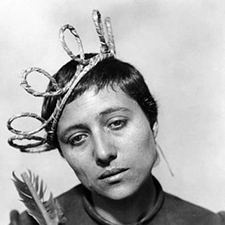
Dreyer’s film, which focuses upon the record of Joan’s trial, was equal parts critically successful to financially disastrous upon its initial release, and its immediate history saw a series of cuts and mishaps and made the original a rare and eventually ‘lost’ commodity (the original negative was lost to a studio fire at UFA). Dreyer’s attempted restructuring from a few remaining original prints was then again lost to fire in 1929 (bad fire times all round). Since then, the original film was considered lost entire, until, bizarrely canisters containing the film were found in a cleaning cupboard mental institution in Oslo in the 1980s. After three years at the Norwegian Film Institute the reels were finally examined and found to be Dreyer’s original cut.
Reclaimed, frequently screened at film festivals, given a DVD release and now a part of numerous film syllabuses, the film really does live again in multiple forms.
What I personally want to flag up in contrast with Carrie’s response below is the influence of the contemporary score commissioned for the reclaimed film– which has a major influence upon the film is experienced in contrast to the live accomplishment you will witness with silent screenings at many festivals and events (a great number of diverse contemplate scores have been written for the film since the late 1989s, including Live accompaniments by the likes of Nick cave and Cat power). The power of Richard Einhorn’s 1994 oratorio based on the film entitled “Voices of Light” (available as an optional accompaniment on the Criterion Collection’s DVD release) is rather difficult to put in to words, but the richness and fullness of the soundscape works in startling compositions and contrasts with the sparse nature of Dreyer’s images, the intensity of his compositions that blank all else out against the frantic eyes of Renée Falconetti in the film’s relentless succession of tight, unforgiving close ups as Joan response to each stage of her interrogation. Watch it with the score, watch it without — experience it every way you can, because this is a text that grows and changes each time it’s encountered, and one that carries with it it’s bizarre history of reclamation and restoration that remains just as oddly intoxicating in the overall experience as the film itself.
2. (Re)viewings
(Carrie Smith)
I recently attended a screening of The Passion of Joan of Arc at Birmingham Cathedral as part of the Flatpack Cinema Festival –http://www.flatpackfestival.org.uk/event/the-passion-of-joan-of-arc/ The film was introduced by Paul Shallcross, a pianist who had written a score to accompany it. In his introduction he chose to stress the film’s timelessness. He mentioned that the sets gesture towards medieval simplicity, yet the soldiers wear helmets which look similar to those worn in World War One. He also highlighted the brief incongruent appearance of 1920s plastic spectacles.
Despite the film’s damning portrayal of the Catholic Church, to watch it in Birmingham Cathedral felt entirely appropriate. The cathedral’s high vaulted ceilings, columns, religious paintings etc made you feel that the bishops were about to enter from stage left. The image of the light through the window creating a crucifix on the floor of Joan’s cell was echoed in the stained glass window of the cathedral which was directly behind the screen. The acoustics of the cathedral meant that the score reverberated around the audience. The walls seemed to lean inwards towards Renée Maria Falconetti’s expressive face at the centre of the space.
Too often, perhaps, films are confined to being watched in the archives and do not have the opportunity to be shown in spaces which can add new meaning and relevance. Dreyer’s film about intolerance felt like it was interacting with modern questions in a real setting and I would applaud Birmingham Cathedral for agreeing to the screening. It would be wonderful to see more silent films present beyond the archive in a living space and in doing so, able to reach larger audiences.
Round Two of US-Canadian Rivalry
On the 15th of June in 1859, Lyman Cutlar, an American recently settled on San Juan Island, shot a pig which ” … having been at several times a great annoyance and that morning destroyed a portion of his garden … ”
Affidavit of Lyman A. Cutlar Regarding Pig Shooting, September 7, 1859
(click on image to view the complete 5-page document in our Flickr photostream)
The pig belonged to the British Hudson Bay Company who demanded compensation in the amount of $100. The astonished Cutlar valued the pig at less than $10. While not the shot heard round the world, it did mark the beginning of the Pig War-a border dispute between the United States and Canada. While that was the only shot fired, twelve years of posturing on both sides which included troops and navies and some soon to be famous Civil War principals, George E. Pickett and Winfield Scott. The Treaty of Washington between the United States and Great Britain was signed in 1871 and the San Juan Island matter referred to Kaiser Wilhelm I of German for arbitration and in October of 1872 ruled in favor of the United States.
An early commemoration of the anniversary of The Pig War was the excuse for the staff of the National Archives in Washington and our friends across the street at the Canadian Embassy to once again test public opinion-this time on bacon. Last … [ Read all ]
New Beginnings
Well ladies and gentlemen, it’s that time of year again to whip out your tissues and get ready to send our lovely seniors into the real world to make us all very proud. As they walk the Laurie Auditorium stage on May 18, 2013, they will be ending one adventure and starting a new one (cheesy…I know). One of our very own down here in Special Collections, Faith Bradham, will be starting her new life in August at Indiana University, attending graduate school to become a librarian and spreading her love of books to everyone she can. Your Special Collections family is very proud of you, Faith– now go do awesome things and never forget that we’ve always got your back!
 |
| Trinity University diploma from the Waxahachie campus |
Although the beginning and ending ceremonies are held in Laurie Auditorium both freshmen and senior year, it was not always this way. Previous ceremonies on the Skyline campus were held in the Sunken Gardens, located directly across the 281 highway and walking distance from campus.
 |
| Trinity University Spring Commencement at the Sunken Gardens |
Due to lack of space (and probably the unbearable Texas heat), the ceremonies were eventually moved inside. Because, lets be honest, who wants to sweat up a storm under one of those polyester graduation gowns in the 100 degree temps? Not me. However, that has never stopped friends and families from enjoying the outdoors as they take photographs outside by the Miller Fountain and the Trinity Tower to commemorate this important day.
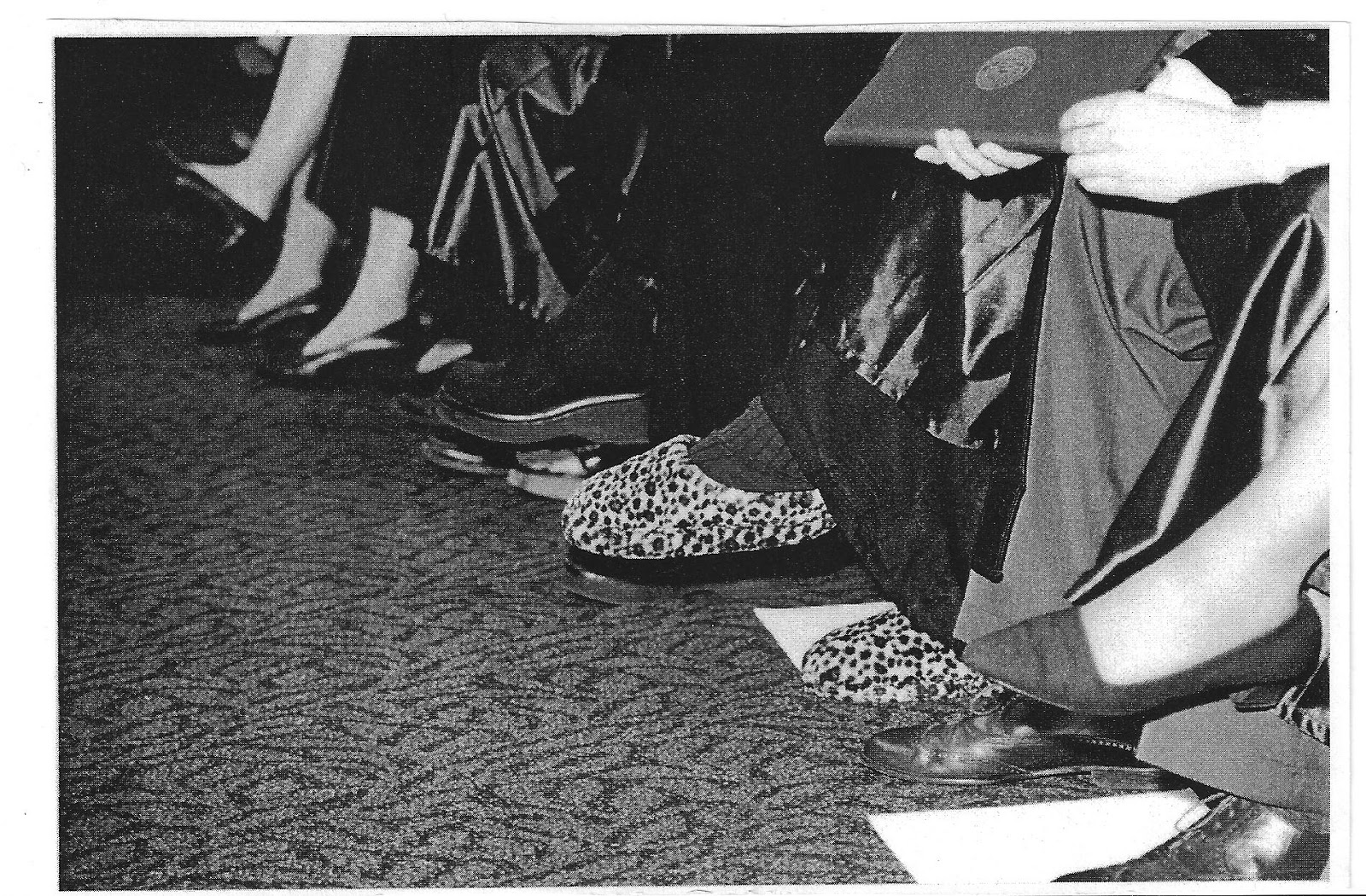 |
| Trinity students have been known to add a personal touch their graduation day attire |
In addition to walking the stage on graduation day, graduating seniors also have the opportunity to leave their mark on Trinity, specifically on the iconic Trinity Tower. As wide-eyed first years, students climb the Trinity tower, taking photographs at the top with the University’s president. When graduating, students climb the tower once more, this time signing a brick at the top (which will cost $20.13 this year–see what they did there?). Therefore, while graduating, seniors participate in similar ceremonies as they did four years ago, this time transitioning out of college life and into a new phase in their lives.
Oh, and try not to trip…
Continuity of care #3
As our project team continues to clean and prepare for use the case books of Stirling District Asylum we are discovering a wealth of additional information in the enclosures which are pinned, fastened or interleaved throughout the volumes. The case notes written in the pages of the case books record the initial personal and medical information collected at the time of admission and go on to provide regular updates on the treatment and condition of patients during their stay in the asylum. The enclosures, which are being carefully removed and catalogued, provide further medical and personal information relating to the patients.
Detailed accounts of the condition and behaviour of patients prior to admission are recorded in official correspondence from doctors, parish councils and other asylums from which patients have been transferred. Extracts from the medical certificates which were completed prior to admission are also sometimes included. Occasionally the incidents that triggered admission to the asylum were reported in the local press and press cuttings of such events were often placed alongside the case notes. Evidence of the care and treatment of the patients can be seen in the various hospital forms and records which are present including temperature charts, eye-test forms and additional loose case notes.
Alongside these official records the case books also include the personal correspondence of the patients themselves, an additional layer of evidence which brings their stories alive. The letters written by patients were intended for family and friends but these handwritten messages never left the asylum, instead being added by the hospital authorities to the case notes as evidence of the patient’s state of mind. Indeed some of these letters provide vivid first-hand accounts of the delusions and hallucinations suffered by patients. Many write of being kidnapped and held against their will, or ask for help to escape their incarceration. Other letters, however, are more measured and considered, apologizing to parents or spouses for their recent behaviour and asking loved ones to come and visit.
It is heartening to note that not all patient correspondence was confined within the walls of the asylum. The enclosures also include the occasional letter written by a recovered patient to the doctors in the asylum thanking them for their treatment and providing an account of life since their return home.
Open Government Appreciations
This week the American Society of Access Professionals (ASAP) honored the National Archives with its two highest awards. The President’s Award for Distinguished Public Service was awarded to Miriam Nisbet, Director of our Office of Government Information Services (OGIS). And the Director’s Award for Superior Public Service was awarded to the Public Interest Declassification Board (PIDB). PIDB is an advisory board created by Congress to promote access to national security decisions and activities. Our Information Security Oversight Office (ISOO) Director serves as the PIDB Executive Secretary and ISOO staff support the work of the board.
The President’s Award is the highest honor that ASAP grants recognizing distinguished and sustained contributions in the furtherance of the public interest with respect to access, privacy, and fair information laws, policies, and practices. ASAP noted Miriam’s work in FOIA at the Justice Department and then in the National Archives General Counsel’s office during the 1990’s, as legislative counsel for the American Library Association and then UNESCO in Paris. Special recognition was focused on her work to establish and head OGIS, created by the 2007 amendments to the FOIA. In accepting the award, Miriam pointed out that she had grown up along with the FOIA and that OGIS represents the maturity of a law that is one of the hallmarks of open government and democracy.

“Open for Business,” by cartoonist … [ Read all ]
Radio Pioneer Tommy Cowan Announces a Parade of History
Beginning as an office boy for The World, Tommy Cowan went on to be Thomas Edison’s receptionist, greeting important visitors to the inventor’s laboratory in West Orange, New Jersey. From there he was the first announcer on the air in the New York metropolitan area when WJZ Newark started broadcasting in 1921. He announced the first World Series broadcast based on descriptions phoned into him from the game, as well as covering the June, 1924 Democratic National Convention from Madison Square Garden.
WNYC’s founder Grover A. Whalen convinced Cowan to be WNYC’s Chief Announcer, and his was the first voice heard when we went on the air July 8, 1924. In his 1951 oral history session with Columbia University, Cowan talks about being on the air for the myriad of parades, receptions and celebrations from the 1920s through the 1950s, especially early on when athletes and aviators [1] came to town after making or breaking world records. For Charles Lindbergh in particular, he says, WNYC followed the flyer all around the city for a full day-and-a-half. [2] Other distinguished guests included: Queen Marie of Romania, English Channel swimmer Gertrude Ederle, British Prime Minister Ramsey MacDonald, Admiral Richard E. Byrd, aviatrix Amelia Earhart, heavyweight champion Gene Tunney, golfer Bobby Jones, Premier of France Pierre Leval and many others.
Cowan also recalls that WNYC’s Masterwork Hour, radio’s first regularly scheduled broadcast of recorded classical music in 1929, was a significant influence on pioneering radio engineer John V. L. Hogan, the founder of W2XR, WQXR’s predecessor. On a visit to WNYC’s studios Cowan quotes Hogan as saying, “I’m going to found a radio station on the basis of your Masterwork Hour and present only classical music with no advertising.”[3]
Cowan was well versed in New York City history and an avid opera fan. At one point he hosted a regular WNYC opera program called Velvet and Gold. The writer Lee Murphy described him this way:
“A delightful old sprite of a man by the time I met him. An opera lover whose Monday at 8 PM performances, recorded by the world’s greatest artists, were legendary. Each was preceded by a totally ad-libbed description of the evening’s opera, highlight of the libretto and critiques (mostly positive) of the singers. These expositions which might take 10 to 15 minutes, were delivered with verve and humor and love for the music. But no script. I learned much from Cowan, listening to him and grasping at the wonder of how his mind advanced the narrative, sometimes logically, sometimes not, but always pulling his audience forward and into the opera’s legend or fable or myth. However, as much as Tommy loved opera, he could easily denounce other disciplines. He disdained, for instance, what he called ‘chamber-pot music’. Of popular music, he knew nothing, or at least nothing he’d admit to…” [4]
In his New York Times obituary he was quoted as saying, “I don’t live in the past, but I do respect the fact that I came from Adam and Eve, and you have to look back once in a while.”[5] Tommy retired from WNYC in 1961. He died in November, 1969.
Cowan, ever energetic raconteur of the air, was always ready to fill any dead space with a descriptive word picture of the scene before him. To listen to more than 40 broadcasts with Tommy go to: COWAN.

[1] There is an especially wonderful New York Times photo (#3 in the slideshow) of Tommy Cowan gripping two WNYC microphones to the right of aviatrix Amelia Earhart and Mayor Jimmy Walker at City Hall in June 1932. See: EARHART.
[2] “Reminiscences of Thomas H. Cowan,” 1951, on page 54 in the Columbia University Center for Oral History Collection (hereafter CUCOHC).
[3] Ibid, pg. 90.
[4] Murphy, Lee, Get That Kid Outta Here…!, Author House, 2009, pgs. 199-200.
[5]“Thomas H. Cowan, First Voice of City’s Radio Station, Is Dead,” The New York Times, November 12, 1969, pg. 47.
Buildings on the beach side of Beach Avenue
Earlier this year, Harry Swain of Victoria donated a photograph to us and it caused great excitement. Here it is:
Here’s why we were excited. The 1900 and 2000 blocks of Beach Avenue no longer have buildings on the water side. There are very few good views of the buildings that existed there and nearly all of them were taken from the beach rather than from across the street. This is the only view we have that shows these long-gone buildings from this angle.
This view down English Bay beach shows the direction from which the photograph must have been taken: high up in the Sylvia Court apartment building (now a hotel), facing the buildings in the distance.
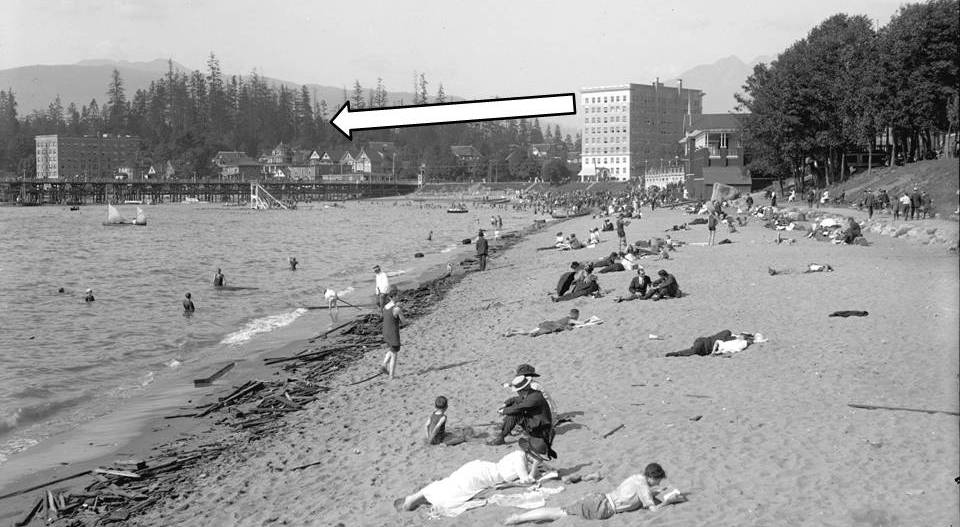
English Bay beach, showing bathers and surrounding buildings, about 1913. Detail from Reference code AM54-S4-: LGN 1030
For a completely different (and not photographic) view of these buildings, we can look at Fire Insurance Plans. These detailed plans were created by fire insurance underwriters to evaluate fire risks.
This plan was created in 1893 but updated to 1901. The updates were made by gluing new pieces of paper onto the old plan. You can see that the alignment is a little off here:
There were a few buildings on the water side. The real fun was a few blocks over.
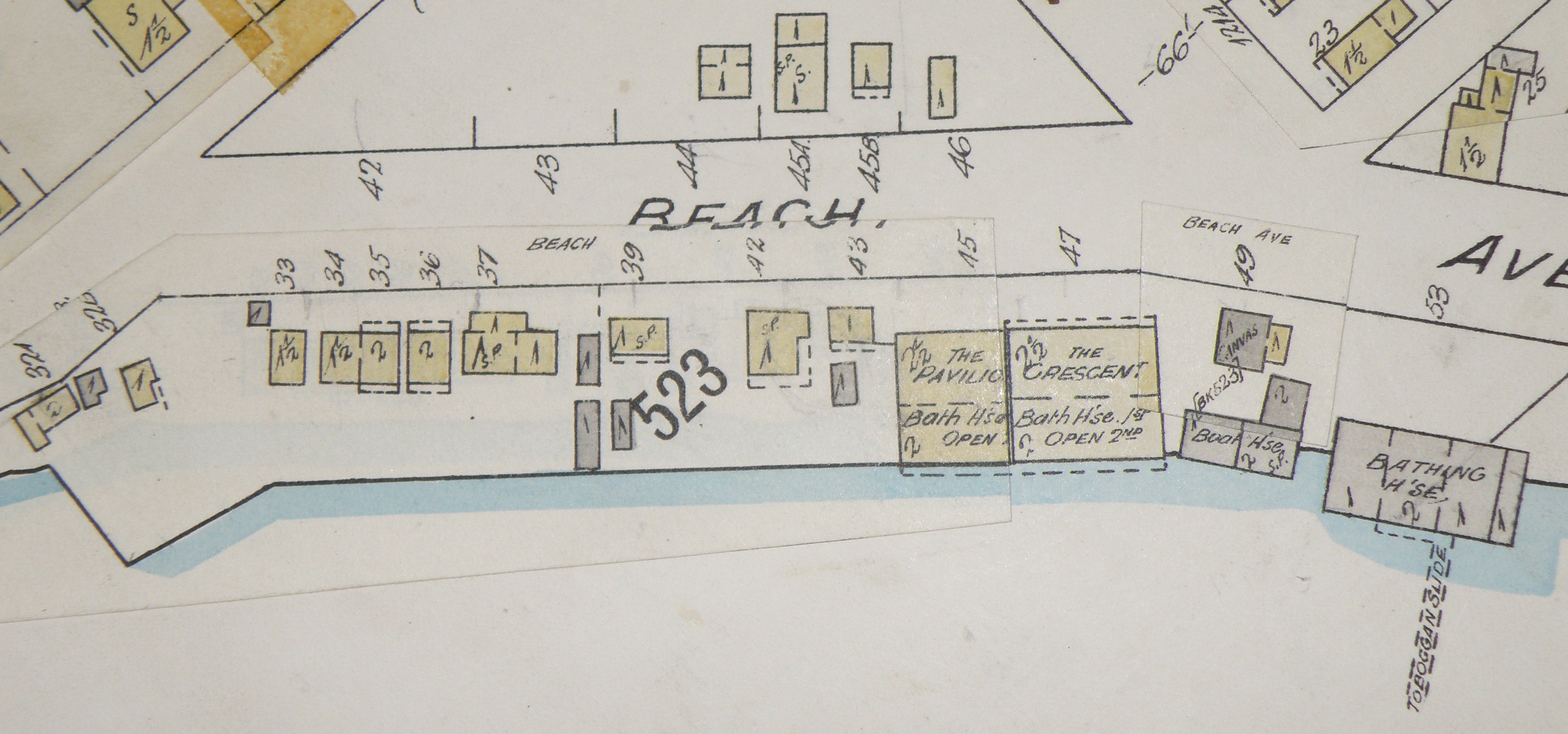
Detail from Map 384, showing buildings further along Beach Avenue. Note the toboggan slide in the lower right corner!
The following plan is from 1912, closer to when the 1913 photograph was taken. Note that the original shoreline was outlined. This plan was annotated in pencil by Major Matthews, the first City Archivist. We don’t write on the records any more.
The photograph would have been taken from pink building “7” (the Sylvia), facing toward the Englesea Lodge.
Another view of these buildings from a few years later is the hand-coloured photograph we used as our first Twitter background.
This photograph gives a good view of the Alexandra Park bandstand and the English Bay Pier.
In 1909, large boulders were removed from the beach and used for the construction of English Bay Pier, and sand was pumped from the ocean bottom to create the sandy beach. The Pier was demolished in 1939.

Alexandra Park Bandstand. It appears that these two women are moving concert equipment, probably chairs. Detail from reference code AM54-S4-: Be P93
Alexandra Park Bandstand was built in 1914 and concerts were subsequently held there instead of at the Pier bandstand. It was renamed the Haywood bandstand to acknowledge the contribution made by Haywood Securities toward its 1987 restoration. It is now a designated heritage building protected under City of Vancouver Heritage By-law No. 4837.
For more on the buildings on these blocks, especially Englesea Lodge, see this post by Eve Lazarus on her blog.
Amherst College Digital Collections Update
We are delighted that so many people are using the Emily Dickinson manuscripts we made available through Amherst College Digital Collections. Over the past six months we have digitized other materials from the Archives and are pleased to announce that hundreds of new digital images have been uploaded and are now available to researchers the world over.
The development of Amherst College Digital Collections — ACDC for short — is a highly collaborative process. We work closely with the good folks in the Frost Library Digital Programs and Technical Services departments, and Amherst’s Information Technology to identify materials, image them, provide useful metadata, and get them uploaded to ACDC. The latest additions come from a wide range of collections in the Archives, including some great material from Dickinson’s contemporaries Edward and Orra White Hitchcock.
We are in the process of digitizing everything in the Edward and Orra White Hitchcock Papers, but it’s going to take quite a while to work through all 31 boxes so we’re making material available online as we go. Among the materials currently available are the classroom charts that Orra White Hitchcock painted for use in her husband Edward’s lectures on geology. Edward Hitchcock is responsible for building the outstanding collection of dinosaur tracks held by Amherst College in the Beneski Museum of Natural History. Now anyone with an internet connection can see Orra’s illustrations of these specimens and read Edward’s account books for the Natural History Fund. Anyone interested in nineteenth-century science, particularly geology, will find a treasure trove in the Hitchcock materials now online.
Last September, Rebecca did a post about a manuscript memoir written by Royal Cole. Now the whole of this document is freely available in ACDC.
In a post here last summer, Mimi wrote about “The Flight of the Eagle” by John Burroughs. This manuscript is now in ACDC.
Last, but not least, we have added four photo albums full of pictures of Amherst’s sister school in Kyoto — Doshisha University — from our Doshisha Collection.
Stay tuned for more updates about Archives & Special Collections materials being added to ACDC!
2012-2013 Carolinian issues now online
As the spring semester closes, we have have added the past year’s issues of The Carolinian to the online archive. Except for a fair number of issues from 1945, of which there are no known print copies in existence, almost the entire run of UNCG’s student newspaper is currently available online. The bulk of these were digitized in 2010 and 2011 as part of the Lyrasis Mass Digitization Collaborative. New issues are added at the end of each academic year. Since 2012, these new issues have been published as “born digital” PDF files generated directly from the Carolinian‘s publishing system, resulting in better image quality and superior text search functionality.












